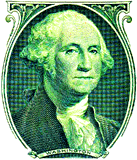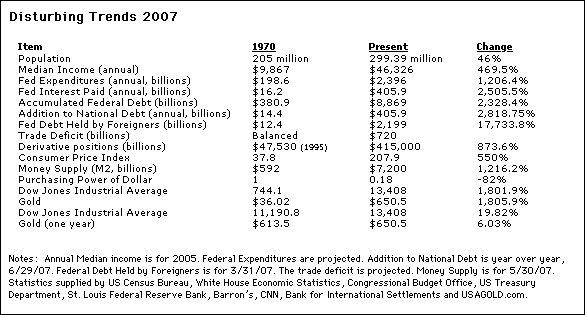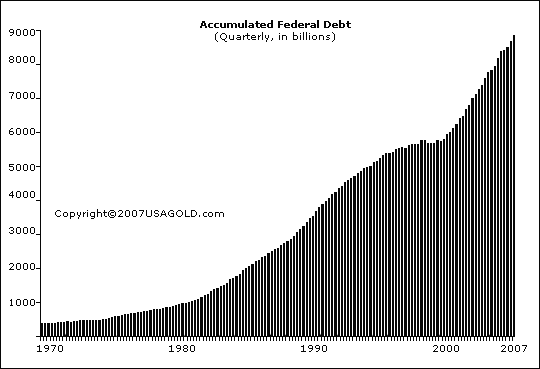Disturbing Trends 2007 - The US Dollar Under Siege
Economics / US Dollar Aug 06, 2007 - 07:53 PM GMT
A critical juncture for gold and the U.S. economy
from the author of
"The ABCs of Gold Investing:
How to Protect and Build Your Wealth with Gold"
_____________
"[U]nder the placid surface there are disturbing trends: huge imbalances, disequilibria, risks -- call them what you will. Altogether the circumstances seem to me as dangerous and intractable as any I can remember, and I can remember quite a lot. What really concerns me is that there seems to be so little willingness or capacity to do much about it. . . We are skating on thin ice." - Paul Volcker, Former Chairman of the Federal Reserve
"[W]e live in a globalized environment and in a country which has enormous fiscal and external deficits. So you have to figure out some way -- which I have not done I might add -- to protect yourself if we should have a real currency problem here." - Robert Rubin, Former Treasury Secretary
From time to time I update this short study - the nuts and bolts of which first appeared nearly ten years ago in my book, The ABCs of Gold Investing : How to Protect and Build Your Wealth with Gold . You might think it odd that I would update the same study on a regular basis, but the fact of the matter is that the message (and its value as a primer) hasn't changed since the book was first written.
 For the uninitiated, Disturbing Trends explores the primary reasons why the economy and financial markets have become so volatile and unstable. It also exposes the reader to the reasons why gold has come to play such a prominent role in the contemporary investment portfolio. For the veteran gold investor, this study serves as a refresher course on why you added gold to our portfolio in the first place and encouragement to stay the course.
For the uninitiated, Disturbing Trends explores the primary reasons why the economy and financial markets have become so volatile and unstable. It also exposes the reader to the reasons why gold has come to play such a prominent role in the contemporary investment portfolio. For the veteran gold investor, this study serves as a refresher course on why you added gold to our portfolio in the first place and encouragement to stay the course.
Disturbing Trends is simultaneously one of the least and most popular essays I have written. I get numerous requests for reprint. I also get complaints about its bleak view of the future. As the saying goes though, the turtle never got anywhere by keeping his head in his shell. Likewise, he can't avoid danger without first seeing which direction it's coming from. So bleak though it may be, it also serves a positive purpose as a call to action.
To be sure, those who took their cue from this study and purchased gold have been amply rewarded. When "The ABCs of Gold Investing" first hit the bookstores in 1997, gold hovered in the $300 range. It has been in a steady upward pull ever since. As of this update, it is trading in the $670 range. Price appreciation, however, is a sidebar to gold ownership. The main story is gold's asset preservation qualities.
Thus far the United States has avoided paying the piper for its economic sins because of the dollar's position as the world's reserve currency - what French president Charles DeGaulle called "the exorbitant privilege." Just over the past year though, a growing list of countries have switched course and begun substituting dollar holdings with other currencies and gold in their reserves. Unless something changes, the days of "exorbitant privilege" could be suddenly coming to an end. If so, the dollar will find itself under siege like it never has before.
When former Treasury secretary Robert Rubin tells us (as quoted in the masthead) it would be advisable to figure out some way to protect ourselves against a currency problem in the United States, he is referring to the loss of that exorbitant privilege. He doesn't mention gold, but one can read between the lines. There is every bit as much reason to own gold today as there was in 1997 when this study first made its appearance. In fact, the argument for gold has never been stronger.

Disturbing Trend #1 : The Alarming Growth in the U.S. National Debt
"It [this new budget approach] will retire nearly $1 trillion in debt over the next four years. This will be the largest debt reduction ever achieved by any nation at any time." - President George W. Bush, February 28, 2001
During the four years following that Bush administration initiative, instead of reducing the national debt by $1 trillion, the federal government actually increased it from $5.7 trillion to $7.7 trillion. That's a $3 trillion dollar swing between hope and reality. Now, seven years later, the national debt stands at $8.9 trillion - nearly $30,000 for every man, woman and child in the United States. And there appears to be no end in sight to the fiscal madness. The debt clock ticks non-stop at the rate of about $1.3 billion per day.
I should point out that there is a difference between the "deficit" and "additions to the national debt." The deficit often quoted by politicians and the mainstream press is discounted by borrowings from the social security fund - a machination meant to dilute the real budget deficit which is the actual addition to the national debt.
Thus the accompanying graph illustrates the real accumulated deficits, i.e., the alarming and very real growth in the national debt. For a short while in the 1990s, it looked like this troublesome problem might at least be held at bay, but along came the military build-ups in Afghanistan and Iraq, the general war on terrorism, increased entitlement outlays and out the window went any semblance of fiscal restraint.
President Franklin Delano Roosevelt famously proclaimed that we shouldn't worry about the deficits because we owe them to ourselves. If the government pays interest, he said, we pay it to ourselves. There was a time when that argument might have held water, though to characterize government debt under any circumstances as benign is a bit specious.
Even so, things have changed. First, we no longer owe it just to ourselves. We owe well over $2 trillion of it to foreign creditors, mostly Japan and China. Second, the effect of the national debt is far from benign. It is the principle driving force behind higher taxes, inflation and the depreciating dollar. Third, few people know that in its own right interest on the national debt ranks third in federal budget outlays after military spending and social welfare entitlements.
When you blanch at the $50 to $75 it takes to fill your gas tank and suffer food prices running through the roof, think about the national debt. When Congress inevitably raises the income tax, think about the federal debt. When you hear about the dollar plummeting on foreign exchange markets, think about the federal debt. It is perhaps the most insidious, entrenched and debilitating of the disturbing trends threatening the nation and our economic well-being.

Read the full article of Disturbing Trends #1-6 , and tips to bolster your portfolio:
#2) The Alarming Growth in the Trade Deficit
#3) The Disappearing Real Rate of Return
#4) The Explosive Growth of Derivatives
#5) The Alarming Growth of Foreign-held Debt
#6) The Long-Term Decline of the U.S. Dollar
HOW TO manage the gold component of your portfolio
For more information on the role gold can play in your portfolio, please see The ABCs of Gold Investing : How to Protect and Build Your Wealth with Gold by Michael J. Kosares.
By Michael J. Kosares
Michael J. Kosares , founder and president
USAGOLD - Centennial Precious Metals, Denver
Michael Kosares has over 30 years experience in the gold business, and is the author of The ABCs of Gold Investing: How to Protect and Build Your Wealth with Gold , and numerous magazine and internet articles and essays. He is frequently interviewed in the financial press and is well-known for his on-going commentary on the gold market and its economic, political and financial underpinnings.
Disclaimer: when considering any market analysis, bear in mind that past trends do not necessarily guarantee future performance.
Michael J. Kosares Archive |
© 2005-2022 http://www.MarketOracle.co.uk - The Market Oracle is a FREE Daily Financial Markets Analysis & Forecasting online publication.



